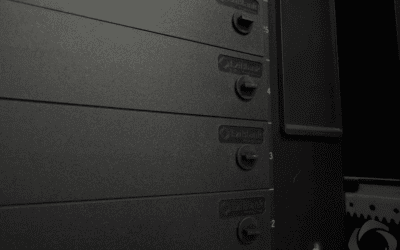What Exactly is a Blanking Panel?
In the realm of data center management, understanding the function of every piece of equipment is crucial. One such fundamental component that often escapes attention is the blanking panel. Essentially, a blanking panel is a flat piece of either metal or plastic that is designed to fit into empty spaces within server racks. It stays in place until a new server or other hardware needs to be installed, at which point it is removed to create space for the new equipment.
One might wonder why it is necessary to invest in blanking panels if they are destined to be removed eventually. However, once you comprehend their benefits, you’ll quickly realize that they are indeed worth every penny of their affordable cost.
The Crucial Role of Blanking Panels in Promoting Proper Airflow
Server racks are designed to facilitate optimal working conditions for the equipment they house. One way they achieve this is through effective airflow management. Air is allowed to flow through the server rack, absorbing heat from the equipment, and expelling it out of the rack, thereby maintaining a conducive temperature for the servers to operate in.
Modern server racks are engineered to ensure uniform airflow, effectively eliminating the heat. However, this efficient heat removal is only possible when all the slots within the rack are occupied. If there’s an empty slot, the airflow dynamics are disrupted, potentially leading to a range of problems:
- Creation of ‘Dead’ Zones: An open slot in the server rack can lead to the creation of ‘dead’ spots where the air movement is either non-existent or very slow. This can create hotspots, jeopardising the functioning of your equipment.
- Unintended Airflow: The empty slot might cause air to flow from one side of the rack to the other, disrupting the intended flow pattern. Ideally, a server rack has cool air entering from one side and hot air being expelled from the other. If these two streams mix unintentionally, the cooling efficiency will be compromised.
- ‘Tornado’ Effect: When air encounters an unexpected opening, it can blow in unintended directions. This can cause air to circulate within a specific area in the rack rather than being expelled, disrupting the cooling process.
- Reduced Efficiency: If the air has a larger area to traverse due to an open slot, its flow might be less efficient than planned, leading to potential cooling issues.
Blanking Panels: An Essential Tool for Efficient Server Rack Cooling
As the above points highlight, proper airflow is crucial for effective cooling. When you install blanking panels in your server rack, you ensure that the air flows exactly where it’s intended to, maintaining the right temperature across the rack. Given the crucial role that effective cooling plays in the efficient operation of server racks, investing in blanking panels is a small price to pay for the significant benefits they bring.
Keeping Your Server Rack Clean with Blanking Panels
Beyond aiding in effective cooling, blanking panels also contribute to keeping your server rack clean. While data center air is typically filtered, eliminating every speck of dust is nearly impossible. To prevent this dust from getting into your servers and causing potential damage, it’s necessary to ensure that it’s expelled from the server rack as quickly as possible. This is where blanking panels come in. By ensuring uninterrupted and efficient airflow, blanking panels facilitate the quick expulsion of dust from the server rack.
Enhancing the Aesthetic Appeal of Your Server Rack
While aesthetics might not be the topmost priority when it comes to housing servers, there’s no denying that a server rack with blanking panels looks significantly better than one with empty slots. In some industries, a well-maintained server rack can impress clients and drive sales. In others, it serves as a sign of a properly set up rack, something that any IT professional would appreciate.
Blanking Panels vs. Filler Panels: A Matter of Semantics
When discussing blanking panels, it’s crucial to clarify the difference between them and filler panels. Here’s the catch, they’re one and the same thing! The terms “blanking panels” and “filler panels” are used interchangeably in the industry. Don’t let the different terminology confuse you while shopping for this vital piece of equipment. Regardless of what you choose to call them, the critical aspect is to ensure that every open slot in your server rack is occupied by one, maintaining optimal airflow and cooling.
Understanding the Different Materials and Sizes of Blanking Panels
Blanking panels are available in two primary materials: plastic and metal. Each has its own set of benefits and installation methods:
- Plastic Blanking Panels: These are cost-effective and easy to install, requiring no tools. They simply snap onto the server rack and can be easily removed when necessary, making them an excellent option if you anticipate adding new servers soon.
- Metal Blanking Panels: These are fastened onto racks with screws, making them suitable for permanent or semi-permanent use. They are sturdy and provide excellent insulation.
When it comes to size, blanking panels range from 1U and upwards, matching the standard sizes of server rack shelves. The type of panel you choose doesn’t impact your cooling efficiency. You just need to select the size that corresponds to the empty spaces in your rack.




